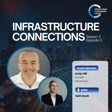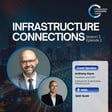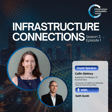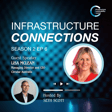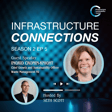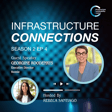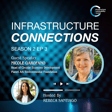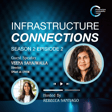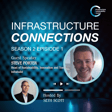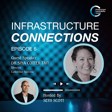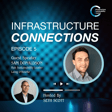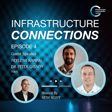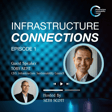Become a Creator today!Start creating today - Share your story with the world!
Start for free
00:00:00
00:00:01

Episode 2 - The Future of Intelligent Infrastructure w/ Anna Robak
Host Seth Scott discusses with Guest Speaker, Anna Robak, WSP Canada's Executive Director, Research & Innovation about her view of the future of intelligent infrastructure. We also take a closer look into six criteria that infrastructure should meet to be considered truly intelligent.
Transcript
Introduction to 'Infrastructure Connections'
00:00:00
Speaker
I would love to see more engineers and scientists have a voice about the way the built environment is being developed and really getting into those policy discussions. Thank you.
00:00:17
Speaker
Welcome to Infrastructure Connections, the podcast where we explore what makes sustainable infrastructure work, brought to you by the Infrastructure Sustainability Council. I'm your host, Seth Scott.
00:00:28
Speaker
Today, we'll be speaking about intelligent infrastructure with our guest, Anna Roback.
Guest Introduction: Anna Roback
00:00:34
Speaker
Anna is Executive Director of Research and Innovation at WSP Canada, a large multidisciplinary engineering consultancy.
00:00:41
Speaker
She also serves as adjunct professor at the University of New Brunswick Civil Engineering Department, and she was on the Mayor's Smart City Task Force for the City of Fredericton. She holds a PhD from the University of South Australia in Applied Economics.
00:00:54
Speaker
Welcome, Anna. Hi, thank you for having me.
Inspired by Environmental Challenges
00:00:59
Speaker
So I wanted to start by going backwards instead of into the future. Tell us about how you got into sustainability in the first place. What started you on this path? And I understand it and involved a bus ride in school through Thailand.
00:01:12
Speaker
Yeah, it's true. It was in high school and i was living in Thailand with my family. My dad was a professor and he was on sabbatical. um And I would take a bus every afternoon from the place where I live, ah all the way to a gym.
00:01:27
Speaker
And one day, the traffic was so bad that I was sat on the bus for about an hour in one spot. And I looked down, there was a dirty canal beside me, and there were kids playing in the canal.
00:01:40
Speaker
And I thought, man, look at all the waste. Like, what if... What if the traffic could flow much smoother? How much more could we give to society? And, you know, if if municipalities or or if the owners ah of this and infrastructure were able to divert their money elsewhere, could we actually create more value, clean up the canals, you know, tidy up the um the blockages in the in the road system and just give people a healthier, happier life. And you know that was maybe a bit naive, but that was my starting point.
00:02:14
Speaker
So how did you get from there to where you are today?
Human Impact on Infrastructure
00:02:18
Speaker
Well, I wanted to be an engineer and I knew that early on. And asset management was the place where I thought, hey, I could really make a difference here. we could help make um assets more efficient in the way they're invested in And then i became an asset manager.
00:02:35
Speaker
And over time, I realized, you know, it's not just about the condition of the infrastructure. It's also how about how the infrastructure gets used by people. And so when I started, everything was all about condition and modeling. And then ah later on, it was much more about how do we have metrics and how do we track our impact on the people that are actually using infrastructure?
00:02:58
Speaker
I think that's one of the things I liked about your research was that you focus very much on the human element rather than just the policy element.
Engaging Design Process
00:03:06
Speaker
And it makes sense that your origin story had to do with helping people because I noticed in your writing, you've you've written quite a lot about that.
00:03:13
Speaker
um In fact, you wrote designing for people instead of designing with people. What does that look like for infrastructure? Well, traditionally, we would see a problem in the world and say, hey, I'm an engineer. I know how to solve that. ah You know, i need to...
00:03:28
Speaker
get people from one side of the river to the other. i will build a bridge. um But over time, as we've solved those big problems, we've left a lot of smaller problems behind. So not everybody can cross the bridge.
00:03:42
Speaker
Not everybody can get out of their house. And so designing with people means engaging the people that will actually be using the infrastructure and understanding their journey all the way through.
00:03:52
Speaker
It takes a really human-centered design process that we're starting to get ah an understanding of in the engineering world, but we could go a lot further with it as well.
Fredericton's Smart Cities Challenge
00:04:04
Speaker
So you were part of Fredericton Smart Cities Task Force, helping the city become one of the 20 finalists in Infrastructure Canada's Smart Cities Challenge.
00:04:11
Speaker
um What makes the city smart? Is it connectivity, sustainability, resiliency? Yeah, sure. So ah the whole Infrastructure Canada Smart Cities Challenge delighted me because it wasn't just about technology and how we use technology.
00:04:27
Speaker
ah It was really about what are society's deep problems. And so the first thing that we did in Fredericton was to ask people, what is the one thing that we need to do better? What is the one big pain point you have?
00:04:39
Speaker
um And we got their response. And so that, of course, is that, you know, the what we will do with how we get people to move around.
00:04:50
Speaker
And the biggest challenge actually was just people getting to be able to access work, to be able to access study and that sort of thing. So there's that um connectivity in the physical sense But in the broader sense, of connectivity in a smart city is also about having information flow around.
00:05:10
Speaker
And again, it doesn't mean that you need to have sensors everywhere, but it means there's that flow of information. Where does that information come from? ah It can come from all kinds of places. And it's true that we tend to think about sensors, ah maybe even drone images now and satellite images.
00:05:25
Speaker
ah But it's also about people who want to tell their municipality or who want to tell asset owners what it is that they need. And so we have to get a lot smarter about the way we prepare ourselves to absorb and use that information.
Future Ready Program at WSP
00:05:40
Speaker
That's a perfect segue into our topic. um So WSP's Future Ready program is works with the speed of technological advancement having no historical precedent and and assuming that it will continue to transform almost every industry in every country.
00:05:55
Speaker
And the breadth of depth of changes are advancing entire systems of production management and governance. I can't agree with that more. I mean, I see that as we move into this new industrial revolution, but how do you narrow that down into an actionable front?
00:06:10
Speaker
Yeah, it has been a journey. So in our Future Ready program, we look at four types of trends, of mega trends. We look at climate, society, technology and resources.
00:06:22
Speaker
And we look at those predictions that are out there that say what will happen 10, 20 years from now. And then we think very explicitly about what that means for the work each of our employees does. So you're a bridge engineer.
00:06:36
Speaker
um Often you're probably already thinking about different climate aspects, but are you thinking about society and how that will change over time? So we take really explicit trends and forecasts and consider what that will mean for the design and how that might need to change so that 20 years from now, because the infrastructure will still be there 20 years from now, it is suitable for the people that will be using it then.
Criteria for Intelligent Infrastructure
00:06:57
Speaker
If we've done it right. In fact, in your article, Six Criteria for a Truly Intelligent Infrastructure, you outlined six key criteria that infrastructure needs to meet in order to be considered truly intelligent.
00:07:08
Speaker
Could you walk us through those six criteria and briefly explain why each one is so important for making infrastructure intelligence? um The first one is that the infrastructure is just part of an intelligent society. So, you know, you need that infrastructure to work.
00:07:24
Speaker
um But it works for people. It's not something that we create all these sensors again and we have all this great smart city of the future. um There's a purpose to it.
00:07:35
Speaker
The second criterion is that we recognize that our infrastructure is just one part of a network. And so when you see it as one part of a network, then you start to see that maybe where one infrastructure starts to fail, another one could take over. And when I say another one, it could be a completely different type. So an example would be a water treatment plant.
00:07:58
Speaker
um Do we need to rebuild a water treatment plant with another water treatment plant? Or could we start leveraging more of those natural assets?
00:08:08
Speaker
The third criterion is about the fact that the intelligent infrastructure monitors its own performance and learns. now Now we're getting into the more really advanced intelligence of the infrastructure in more of a technical way.
00:08:23
Speaker
The fourth criteria is that this infrastructure sees those trends that we are talking about and increases its resilience to those future shocks and stresses.
00:08:35
Speaker
The fifth is that it can actually control and manage itself. And the sixth, and this one I think is really important because we can get excited about technology, but it's that we have more benefits than costs to this technology. And the reason that's so important is that we can get really hung up in what we can do with AI, what we can do with sensors.
00:08:57
Speaker
um But at the end of the day, Do those things that we add bring us more benefit? um You know, example, you might put in some, a simple controller, a control valve um for a water treatment plant. And what we typically know is that the control valve will be made to tell ah we get some ah water coming in, we can measure that water quality.
00:09:23
Speaker
And then the control valve can say, hey, I think you need more of this or more of that to, you know, to give us a better water quality. And we know that the outcome is good because the water quality is good at the end.
00:09:34
Speaker
um But it's also possible to introduce new technology that really doesn't add a lot. I like that idea of infrastructure being proactive rather than reactive, that the infrastructure can actually actively work to solve problems as it goes along.
Proactive Infrastructure Systems
00:09:51
Speaker
So how can infrastructure systems actually predict problems of user needs and act on them in advance? i mean Do we have any examples of that today or infrastructure being predictive or proactive rather than just reactive?
00:10:02
Speaker
Yeah, and so there we're not just talking about the infrastructure, right? We're looking at the environment and around it. um As an example, we could have data that are showing us what's happening within a city, what's happening with the traffic.
00:10:14
Speaker
ah Maybe there's an event going on. and maybe in the past, things like this is this have happened and there have been a major incident. Maybe there's a you know crash on the highway or something like that. So this is a pretty basic example.
00:10:27
Speaker
um But with that, we can see Based on what we've had in the past, we can see that crashes will happen again in the future in this kind of situation in a way that if we hadn't brought all of that data together, ah you know, maybe somebody would tell us and we'd say, oh, yes, of course, that makes so much sense. But we actually hadn't predicted it at that time.
00:10:45
Speaker
That's true, because we can predict the event with regularity, but we can't. So that means we should be able to predict any impact on infrastructure. That makes sense. One really good example would be having sensors of on bridges.
00:11:00
Speaker
It's a pretty basic one. We've had sensors for years, but having a sensor having sensors on bridges and also being able to monitor the traffic going over the bridge, when we bring those two pieces of information together and then layer on top of that environmental data,
00:11:15
Speaker
ah we can start to really understand the performance of that bridge over time. So how is it behaving when the traffic rolls over it? um How is that changing over two, three years as the traffic rolls over it? And what is that doing to the overall performance of this bridge?
00:11:31
Speaker
And we can learn over time how quickly the condition of the bridge is deteriorating based on having had all of that data. So that's just one example. It's a pretty simple one, but I think you could start to extend that into an entire network and all kinds of different infrastructure as well.
00:11:49
Speaker
In some of your research, you've made an interesting point saying we'll start building more infrastructure to protect us from climate change, more energy consumption, larger water storage tanks, more mining, all resulting in more technology needed.
Climate Change and Infrastructure Costs
00:12:02
Speaker
How do you see that play out? So there's three ways that I think climate change is going to increase the cost of our infrastructure. I mean, I don't just think it we're seeing it already. So for one, as you say, maybe we have to build up more. So example, we're seeing more flooding. We have to build up floodplains.
00:12:18
Speaker
um It also means that ah we'll have more demand for our infrastructure. We have to make it bigger. So we'll have drier spells. So we need bigger water reservoirs.
00:12:30
Speaker
And the third element is the cost unit costs of building our infrastructure. And this is ah especially important for ah infrastructure because there's people outside working on it. And when you're working outside, you're more exposed to the elements.
00:12:47
Speaker
um More heat means more heat stress, means more time off, or maybe it means means more protection from the elements. More storms means we have to stop construction more often. um And so there's there's all of those elements that come together that just increase the costs of our
Balancing Energy Consumption and Innovation
00:13:04
Speaker
infrastructure.
00:13:04
Speaker
What do you see that leading to with more energy consumption, with more material consumption? Do you see that as necessarily a bad thing or do you think that will help us innovate? um That feels like a loaded question. ah it it cannot be good, certainly using more energy.
00:13:20
Speaker
On the other hand, and introducing smart technologies has all kinds of brings us all kinds of opportunity here to reduce the consumption of our infrastructure. So, for example, again, thinking about water I mentioned more hot days mean that we need more reservoirs. But actually, that's if we're thinking from an infrastructure perspective. If we're thinking from a people's perspective, we could be nudging people and informing them about the level of water that they are currently using, where the reservoir levels are at right now, and letting them know that perhaps it's time to reduce their consumption.
00:13:57
Speaker
So that's one way that we can use technology to reduce water. but One way you can use technology to reduce energy consumption overall and materials consumption.
00:14:08
Speaker
Another way is on construction sites. um There's all kinds of ways that we can reduce um ah just movement of vehicles around construction sites, making sure that people and vehicles are at the right place at the right time, simply by having RFID technology, geolocating the resources on site, ah making sure that we bring in materials just in time so we don't need more space for those.
00:14:33
Speaker
ah So that's just a couple of examples. So it's interesting to see how you're tying it all together because you've got the technology on one hand, like AI and sensors, but then you've also got the human behavioral element working with them to make sure that their behaviors are and and the infrastructure that they work with are beneficial together.
Nature-Based Solutions in Infrastructure
00:14:51
Speaker
and You also have an interesting take that nature is a technology. You've described such techniques as wetlands to prevent flooding, rain gardens, green roofs and walls, trees for shade, permeable pavement.
00:15:05
Speaker
And this was something our previous guest, Toby Kent, had mentioned, um asking about how the intelligent infrastructure information gathering is actually going to be able to benefit natural management.
00:15:17
Speaker
Absolutely. So first of all, nature can be, I don't want to say a substitute, um a friend, a, yeah you know, a way of helping our infrastructure work. So my favorite example has always been from the Catskills in New York. And I have to say it's been slightly debunked.
00:15:36
Speaker
um But let me illustrate because it's a beautiful story all the same, and it has some real lessons in it. um So it was back in the eighty s And New York City realized that they needed to upgrade their water treatment plant and that it would cost billions of dollars.
00:15:51
Speaker
And they decided instead of spending these billions of dollars that they would work with land owners upstream. They would work with farmers upstream. They would grab, you know, they would buy some land. They would work with farmers on nutrient management programs so that their animals were, um you know, putting less pollutant into the water.
00:16:11
Speaker
um They were using it to plant plants. And so because of all of that, they save themselves billions of dollars in needing to do this upgrade. And so that just illustrates, you know, that is the kind of thing that we're talking about.
00:16:24
Speaker
Now, it's not always that nature can completely replace what we do with engineered solutions, ah but it sure has a role. And I have to say one of the biggest challenges there is simply people knowing how to make decisions about integrating natural assets into a regular engineering system.
00:16:42
Speaker
you know into their portfolio of potential engineering solutions. I'm originally from New York City, so i appreciate that they did that. And I also appreciate that you brought in the dollar value as well. Using nature as infrastructure ended up saving them millions and millions of dollars.
00:16:57
Speaker
I think that's something that we could use more often.
Behavioral Science in Infrastructure
00:17:01
Speaker
um You've also been very interested in behavioral science in your career. um You once said technology requires a deep humanistic understanding before using.
00:17:10
Speaker
I like that view. um What are some of the examples where you've had to use that behavioral science in maybe nudging humans along? Yeah, absolutely. ah Just recently, my supervisor, his area is in waste and energy.
00:17:25
Speaker
And he did a study in Sweden that... it It's so simple and you will have seen it before. You get something in the mail that tells you how much of something you've used, ah how much water you've used maybe, and how much your neighbors are using.
00:17:38
Speaker
And so his was similar. He did it for waste. And so they actually went and measured, they weighed people's waste at their curbside um and they told them how much waste they were producing. And that was really useful and measurably decreased the amount of waste people produce by 10% on average.
00:17:56
Speaker
So there's so much do that can help people just by giving them that understanding and maybe a little bit of shame. Maybe isn't shame so much as data that we're giving them. They have this ability to now weigh their garbage where they never would have before and understand how much they're actually producing.
00:18:14
Speaker
ah Similar results have come when people have received things in the mail that say how much energy they're consuming, compare again, compared to their um neighbors or similar types of users users to them. And that has measurably reduced energy as well. So you're right. Just having that data at hand helps people to make but better decisions and frankly, simply raises their awareness of what might be an issue and why.
00:18:39
Speaker
So I guess there's a bit of a hitch in the plan here, and that is that intelligent infrastructure and AI is going to be applied to new infrastructure, but 99% of our infrastructure is existing and old, and we only replace maybe 1% a year. So how much of an impact can technology have on that existing infrastructure, and how can we work around that?
Upgrading Existing Infrastructure with Technology
00:19:00
Speaker
but For the most part, when we talk about intelligent infrastructure, we're not talking about anything fundamentally different about those infrastructure. We're talking about putting sensors on maybe there's some controls, ah but you know now we have camera the ability to use ah computer vision by using what we can see through cameras.
00:19:20
Speaker
ah We can use satellite imagery, we can use drone imagery. So there's really all kinds of techniques available to us to give us the kind of information that we need to understand how our infrastructure is performing and how we might need to how we might want to adjust its performance.
00:19:37
Speaker
So you're saying we can adapt existing infrastructure to be more intelligent? Absolutely. Or be more intelligent around the way that we use it. Yeah.
Infrastructure and Public Health
00:19:46
Speaker
So I noticed recently your research has taken a turn towards the health benefits of infrastructure.
00:19:52
Speaker
Tell us a little bit about that. Yeah, this is a journey that I've been on over the past six years or so. It came about when a colleague of mine said, hey, there's somebody in the recreation sector that wants to talk about bridging infrastructure.
00:20:05
Speaker
the gap between health professionals and engineers. And initially, my response was just to stare at her a bit blankly. um But I'm always up to these kinds of challenges. And I learned a lot awfully quickly.
00:20:18
Speaker
ah So we did a research piece around all the ways in which our built environment, our engineered environment affects people's health. And ah the crux of it is that about 20 to 30% of chronic disease is because of not enough physical activity and ah poor eating habits.
00:20:37
Speaker
And of that amount, um ah you know, there's all kinds of solutions in the built ah environment. As an example, kids that live within 400 meters of a park are 60% more likely to get the recommended amount of physical activity.
00:20:52
Speaker
And it's similar results when we look at how close you are to a transit station, how close you are to active transportation, if you have a walkable neighborhood with side ah sidewalks, footpaths in it.
00:21:03
Speaker
um So all of those elements of the built environment make such a difference to people's health. And my dream is that we can put this data and information in the hands of doctors who can look at where is it my patients are living?
00:21:18
Speaker
ah Is there a way that I can advocate for them to have better living conditions, to have maybe mold removal in their homes, or maybe say, ah raise up the fact that these communities need places that kids can play and people can walk and feel safe?
00:21:33
Speaker
You're right, we talk a lot about how cleaning up the environment is going to help human health, but that's more of an indirect response. We rarely talk about how the infrastructure itself is going to directly impact human health.
Cybersecurity in Intelligent Infrastructure
00:21:45
Speaker
So where do you see intelligent infrastructure changing our cities in our daily lives in the next 10 20 years? My dream would be very much around the health piece first, that we understand how that built environment is affecting our health. So, you know, the data that are available around where people live and the fairness of it and and where their health is poorer and could be improved of as as a result, um that I would love to see. Yeah.
00:22:12
Speaker
Now, the caution, of course, and again, i think I said when I wrote my article, OT cyber wasn't really a thing. So, you know, there's a risk now of of these systems being hacked.
00:22:25
Speaker
And it's a real risk because between 10 and 15 percent, certainly in Canada, between 10 and 15 percent of um transit companies, hospitals, schools, hospitals, um have already been hacked, which is, you know, kind of a scary thing. And I heard a recent example here ah ah near me in Ontario, where a reservoir had been hacked and some whoever had hacked it let a little bit of water out. But you know, that was it.
00:22:51
Speaker
ah But all of these little hints to what could be if ever everything is intelligent is also a little bit concerning and something we need to really need to look out for. i guess that's the human side of it as well. That's behavior.
00:23:05
Speaker
It is, yes.
Vision for Future Infrastructure
00:23:07
Speaker
How about on the positive side? Where do you see infrastructure changing and improving over the next 20 years? Oh, I think it's going to show us all these different ways that we can live healthier lives, um lives that have a lower environmental footprint, um ways that we can connect with people better. um it you know It could even be to the point where it's helping identify more areas where we could create wealth in our communities.
00:23:34
Speaker
So it might say like, hey, did you know that there's a gap in this? Nobody's offering the service. Nobody's doing this business opportunity. um So I think it has real potential to both improve quality of life and create wealth.
00:23:46
Speaker
Over your long career, what has been the most intractable challenge or the problem most likely to persistently raise its head?
Shifting Mindsets for Future Infrastructure
00:23:53
Speaker
And how have you overcome it? You know, we seem to keep doing the same thing um with our infrastructure, which is having this assumption that The same kind of solutions we've used in the past are still the best solutions. You know, we we have all this existing infrastructure, to be fair, and it's hard to step away from what we have already and and rethink the way we're doing things.
00:24:20
Speaker
um But I would say that is absolutely the toughest thing to break people out of their current mindsets and get them to think about, you know, let's look 20 to 30 years from now and how things could be and start building towards that new future.
00:24:35
Speaker
So again, it's the human side um and it's around the way people are thinking about their infrastructure and taking a step back. And, you know, another part of the challenge there is the political rhetoric we often hear about, hey, if I if we build more infrastructure, then more people will have jobs.
00:24:54
Speaker
um Well, none of it is that straightforward. There's some really fascinating research that shows how much money stays in the community, how much wealth stays in the community when um local companies are the ones that are engaged to build that local infrastructure.
00:25:12
Speaker
And often that's not the way things happen when there's a big infrastructure project, right? It's it's someone from outside that's coming in. um So I think, you know, that side of it, the political or lack of political understanding, I would love to see more engineers and scientists have a voice about the way the built environment is being developed and really getting into those policy discussions.
Encouraging Public Engagement
00:25:35
Speaker
That gets into the next question. of What do you think our listeners can do to help promote intelligent infrastructure, not just our engineers, but people even using the infrastructure itself? i think that they could hell um politicians and their cities, frankly, what it is that they need to have a comfortable environment. So, you know, this instance of in the facility city of Fredericton, we had this survey to ask people what they wanted and what would help them.
00:26:05
Speaker
um That kind of question needs to be asked a lot more. But again, we need to find a way to hear people where they are. um
00:26:19
Speaker
So when when they're already telling us what their challenges are and what their problems are, ah we need to pick up on that, whether it's in social media, whether it's just things that are set out in the street. How can we gather all of that intelligence and make real change?
00:26:33
Speaker
That makes sense. I think that's definitely something that can take us into the future. Well, thank you very much, Anna. It's been a pleasure having you on the show. Thanks so much. it was great being here.
00:26:44
Speaker
Thank you for listening to Infrastructure Connections. Please take a moment to follow us wherever you get your podcasts. And we want your feedback. Drop us a line to let us know what you think. Stay tuned for the next episode where we talk to Christy Graham about the Australian Sustainable Finance Institute.
00:27:01
Speaker
That's coming up next on Infrastructure Connections.
